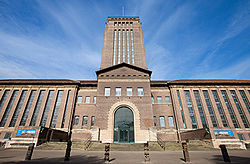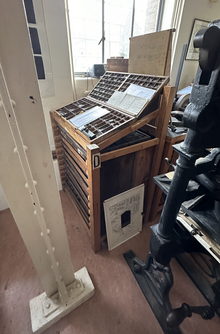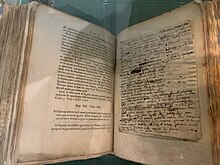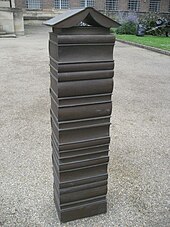
The Bodleian Library is the main research library of the University of Oxford, and is one of the oldest libraries in Europe. It derives its name from its founder, Sir Thomas Bodley. With over 13 million printed items, it is the second-largest library in Britain after the British Library. Under the Legal Deposit Libraries Act 2003, it is one of six legal deposit libraries for works published in the United Kingdom, and under Irish law it is entitled to request a copy of each book published in the Republic of Ireland. Known to Oxford scholars as "Bodley" or "the Bod", it operates principally as a reference library and, in general, documents may not be removed from the reading rooms.

The National Library of Sweden is Sweden's national library. It collects and preserves all domestic printed and audio-visual materials in Swedish, as well as content with Swedish association published abroad. Being a research library, it also has major collections of literature in other languages.

The Vatican Apostolic Library, more commonly known as the Vatican Library or informally as the Vat, is the library of the Holy See, located in Vatican City, and is the city-state's national library. It was formally established in 1475, although it is much older—it is one of the oldest libraries in the world and contains one of the most significant collections of historical texts. It has 75,000 codices from throughout history, as well as 1.1 million printed books, which include some 8,500 incunabula.

The National Library of Wales, in Aberystwyth, is the national legal deposit library of Wales and is one of the Welsh Government sponsored bodies. It is the biggest library in Wales, holding over 6.5 million books and periodicals, and the largest collections of archives, portraits, maps, and photographic images in Wales. The Library is also home to the national collection of Welsh manuscripts, the National Screen and Sound Archive of Wales, and the most comprehensive collection of paintings and topographical prints in Wales. As the primary research library and archive in Wales and one of the largest research libraries in the United Kingdom, the National Library is a member of Research Libraries UK (RLUK) and the Consortium of European Research Libraries (CERL).

A national library is a library established by a government as a country's preeminent repository of information. Unlike public libraries, these rarely allow citizens to borrow books. Often, they include numerous rare, valuable, or significant works. A national library is that library which has the duty of collecting and preserving the literature of the nation within and outside the country. Thus, national libraries are those libraries whose community is the nation at large. Examples include the British Library in London, and the Bibliothèque nationale de France in Paris.
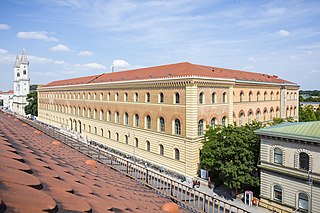
The Bavarian State Library in Munich is the central "Landesbibliothek", i. e. the state library of the Free State of Bavaria, the biggest universal and research library in Germany and one of Europe's most important universal libraries. With its collections currently comprising around 10.89 million books, it ranks among the leading research libraries worldwide. The Bayerische Staatsbibliothek furthermore is Europe's second-largest journals library. Furthermore, its historical holdings encompass one of the most important manuscript collections of the world, the largest collection of incunabula worldwide, as well as numerous further important special collections. Its collection of historical prints before 1850 totals almost one million units.

Glasgow University Library in Scotland is one of the oldest and largest university libraries in Europe. At the turn of the 21st century, the main library building itself held 1,347,000 catalogued print books, and 53,300 journals. In total, the university library system including branch libraries now holds approximately 2.5 million books and journals, along with access to 1,853,000 e-books, and over 50,000 e-journals. The University also holds extensive archival material in a separate building. This includes the Scottish Business Archive, which alone amounts to 6.2 kilometres of manuscripts.

The Scott Polar Research Institute (SPRI) is a centre for research into the polar regions and glaciology worldwide. It is a sub-department of the Department of Geography in the University of Cambridge, located on Lensfield Road in the south of Cambridge.
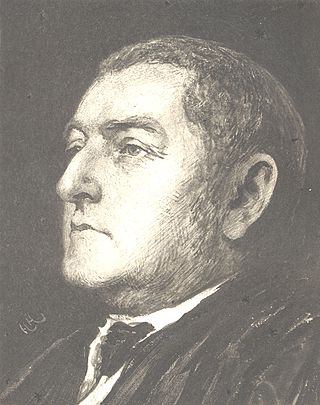
Henry Bradshaw was a British scholar and librarian.

Sir Thomas Phillipps, 1st Baronet, was an English antiquary and book collector who amassed the largest collection of manuscript material in the 19th century. He was an illegitimate son of a textile manufacturer and inherited a substantial estate, which he spent almost entirely on vellum manuscripts and, when out of funds, borrowed heavily to buy manuscripts, thereby putting his family deep into debt. Phillipps recorded in an early catalogue that his collection was instigated by reading various accounts of the destruction of valuable manuscripts. Such was his devotion that he acquired some 40,000 printed books and 60,000 manuscripts, arguably the largest collection a single individual has created, and coined the term "vello-maniac" to describe his obsession, which is more commonly termed bibliomania.

Tobias Rustat was a courtier to King Charles II and a benefactor of the University of Cambridge. He is remembered for creating the first fund for the purchase of books at the Cambridge University Library. He was an investor in, and Assistant of, the Royal African Company, an English mercantile company involved in the slave trade.

The Library of Trinity College Dublin serves Trinity College. It is a legal deposit or "copyright library", under which, publishers in Ireland must deposit a copy of all their publications there, without charge. It is the only Irish library to hold such rights for works published in the United Kingdom.

The British Library is a research library in London that is the national library of the United Kingdom. It is one of the largest libraries in the world. It is estimated to contain between 170 and 200 million items from many countries. As a legal deposit library, the British Library receives copies of all books produced in the United Kingdom and Ireland, including a significant proportion of overseas titles distributed in the UK. The Library is a non-departmental public body sponsored by the Department for Culture, Media and Sport.
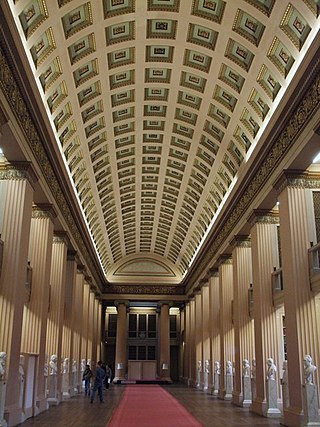
Edinburgh University Library is the main library of the University of Edinburgh and one of the most important libraries of Scotland. The University Library was moved in 1827 to William Playfair's Upper Library in the Old College building. The collections in Edinburgh University Old College were moved in 1967 to the purpose-built eight-storey Main Library building at George Square, one of the largest academic libraries in the world. Today, Edinburgh's university-wide library system holds over 3.8m books, e-books and e-journals in total.
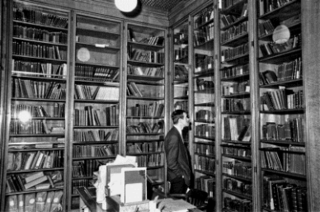
The Private Case is a collection of erotica and pornography held initially by the British Museum and then, from 1973, by the British Library. The collection began between 1836 and 1870 and grew from the receipt of books from legal deposit, from the acquisition of bequests and, in some cases, from requests made to the police following their seizures of obscene material.
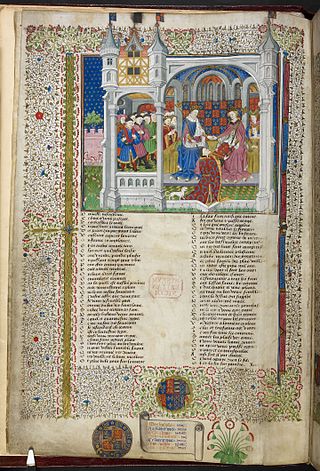
The Royal manuscripts are one of the "closed collections" of the British Library, consisting of some 2,000 manuscripts collected by the sovereigns of England in the "Old Royal Library" and given to the British Museum by George II in 1757. They are still catalogued with call numbers using the prefix "Royal" in the style "Royal MS 2. B. V". As a collection, the Royal manuscripts date back to Edward IV, though many earlier manuscripts were added to the collection before it was donated. Though the collection was therefore formed entirely after the invention of printing, luxury illuminated manuscripts continued to be commissioned by royalty in England as elsewhere until well into the 16th century. The collection was expanded under Henry VIII by confiscations in the Dissolution of the Monasteries and after the falls of Henry's ministers Cardinal Wolsey and Thomas Cromwell. Many older manuscripts were presented to monarchs as gifts; perhaps the most important manuscript in the collection, the Codex Alexandrinus, was presented to Charles I in recognition of the diplomatic efforts of his father James I to help the Eastern Orthodox churches under the rule of the Ottoman Empire. The date and means of entry into the collection can only be guessed at in many if not most cases. Now the collection is closed in the sense that no new items have been added to it since it was donated to the nation.
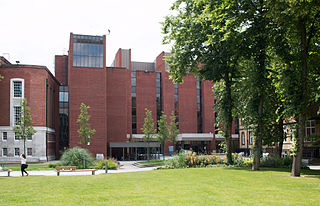
The University of Manchester Library is the library system and information service of the University of Manchester. The main library is on the Oxford Road campus of the university, with its entrance on Burlington Street. There are also ten other library sites, eight spread out across the university's campus, plus The John Rylands Library on Deansgate and the Ahmed Iqbal Ullah Race Relations Resource Centre situated inside Manchester Central Library.

There are over 100 libraries within the University of Cambridge. These include Cambridge University Library, the main university library, affiliated libraries, departmental and faculty libraries, college libraries, and various other specialist libraries associated with the university. Across all libraries, the university houses approximately 16 million books.
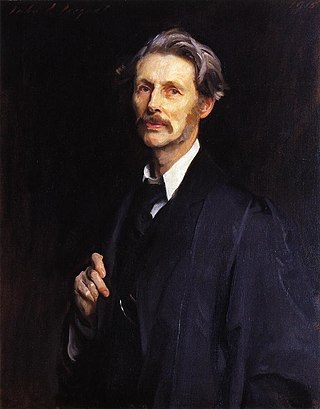
Francis John Henry Jenkinson was librarian of the University of Cambridge 1889–1923. He was succeeded by A. F. Scholfield.

The Selwyn College Library is the library of Selwyn College, Cambridge and an official collegiate library of the University of Cambridge. The current library building is located in Centre Court and was completed in 1929. It was designed by the architect T. H. Lyon as a war memorial library to honour the fallen from the First World War. In 2018, plans for a new library and auditorium in Ann's Court were announced. The current Selwyn College Head Librarian is Sonya Adams and the College Archivist is Elizabeth Stratton.
